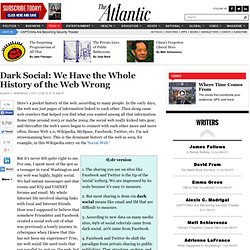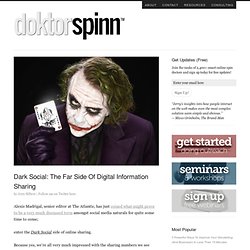

Dark Social: We Have the Whole History of the Web Wrong - Alexis C. Madrigal. Here's a pocket history of the web, according to many people.

In the early days, the web was just pages of information linked to each other. Then along came web crawlers that helped you find what you wanted among all that information. Some time around 2003 or maybe 2004, the social web really kicked into gear, and thereafter the web's users began to connect with each other more and more often. Hence Web 2.0, Wikipedia, MySpace, Facebook, Twitter, etc. I'm not strawmanning here. Tl;dr version 1. 2. 3. 4. But it's never felt quite right to me. To be honest, this was a very difficult thing to measure. Google Image Ranking - How to Get An Image to Rank in Google. The other day I made a post on Google ranking factors so that you have a better idea about what factors influence Google’s ranking algorithm and the estimated weight which is placed on each one.

Google has its own SERPs for images for any keyword, as well. If you click on the image tab in Google, you can search for any keyword to get images related to that search phrase. Clicking on the image takes you to the web page on which that image is shown, so this is another great way to increase website traffic. Therefore, I’ve put together this list of 6 Google image ranking factors which have been proven and vouched for by Google themselves in most cases. Effective keyword use in your image’s file name as well as in its “alt text” tag (see Alt Text vs. Incoming search terms: how are google images rankedhow to rank images in googlegoogle image rankinghow to rank in google imagesgoogle images rankinghow google images are rankedssg rank in jpg file.
Dark Social: The Far Side Of Digital Information Sharing. Alexis Madrigal, senior editor at The Atlantic, has just coined what might prove to be a very much discussed term amongst social media naturals for quite some time to come; enter the Dark Social side of online sharing.

Because yes, we’re all very much impressed with the sharing numbers we see from various social networks, Facebook, Twitter and LinkedIn included. But how much is socially shared in channels we cannot measure, that we cannot see? How much is shared via email, instant messages and direct messages? How much is shared on darknets, BBS networks and untraceable forums? Here’s the summary from the Atlantic article: Ultimate List of Top 29 Tools for Competitive Intelligence. Marketing research isn’t what it used to be.

It has expanded to include the world of websites, blogs, social media, online advertising, and other web-based media. The great thing about this all is that there are lots of tools you can use conduct market research and gather competitive intelligence. Our top posts on Lakeshore Branding have been about social media monitoring and competitive intelligence. So I thought we would share some our favorite tools and this list turned into a description of 29 tools for competitive intelligence.
So check out the list and please let us know if we are missing any. 1. 2. Dark social: Why measuring user engagement is even harder than you think. If you’ve spent any time in a newsroom, traditional or otherwise, you know that publishers are obsessed with measuring where their web traffic comes from.

Whether it’s Google Analytics or Chartbeat or comScore or Omniture, or any one of a dozen other providers, tracking where readers come from is a crucial part of online media — mostly because publishers need to know which channels are worth focusing on, since there are so many to choose from. Is Twitter your biggest source?
Then you should tweet more, and optimize your content for Twitter. Is Facebook a big referrer of traffic? Then you need to be aware of changes to the newsfeed and how they affect you. But what if your biggest source of traffic and readers is something you aren’t even really paying attention to, and something that is extremely hard to track in the same way as Google or Twitter or Facebook? “This vast trove of social traffic is essentially invisible to most analytics programs. Dark Social: The Key to Understanding Content Sharing. Despite all the web analytics tools available to us, marketers don’t fully understand why one piece of marketing content is more successful than another.

We have good end-user data: visits, bounce rate, and so forth — but we have problems understanding traffic sources, favorite ways people share content, and other vital information. I recently read a post written by Alexis C. Madrigal (editor at The Atlantic) that might achieve a breakthrough in helping us know how people share content: dark social. Dark Social is the traffic that arrives to your site when someone shares a post by copying and pasting a URL in an email, mobile, chat, or similar communications method. Those are the sources of traffic that analytics cannot identify — and classifies as direct traffic.